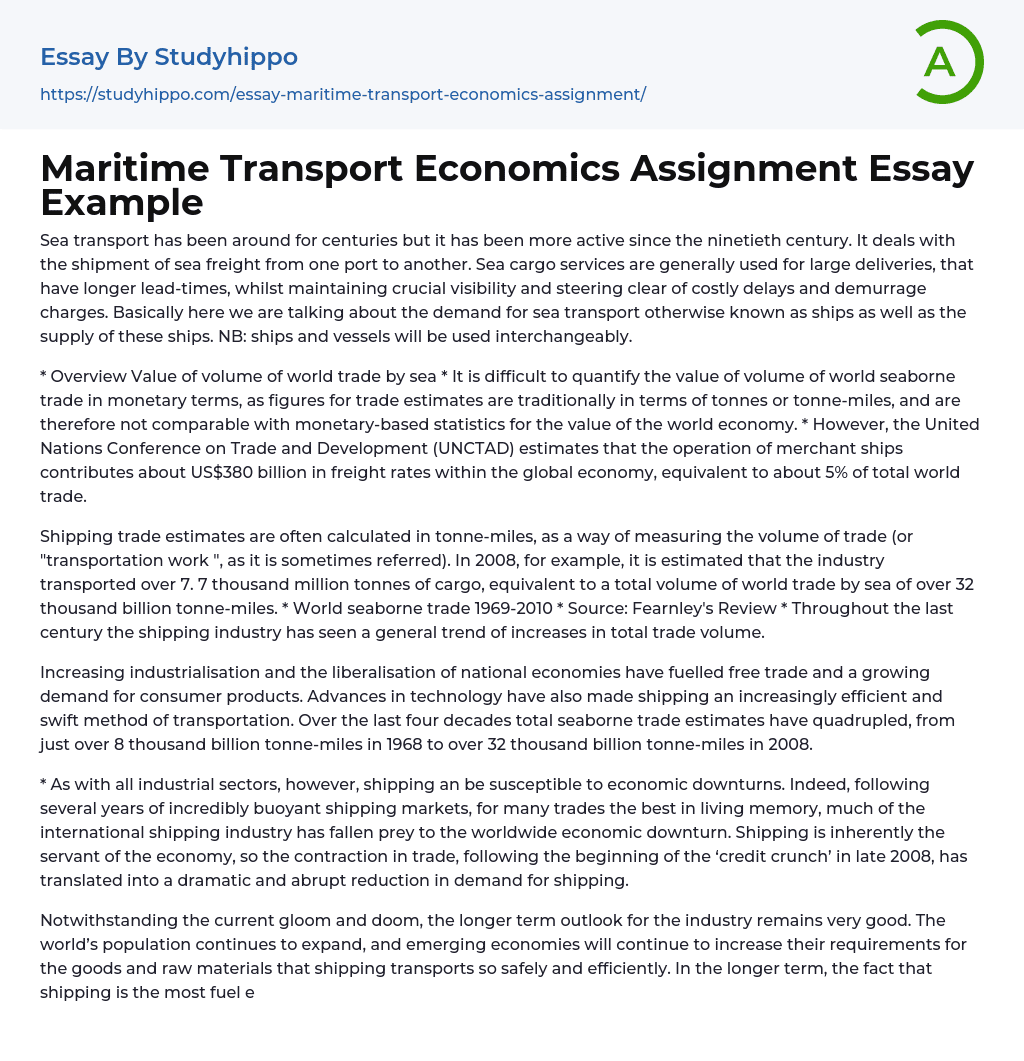Sea transport has been around for centuries but it has been more active since the ninetieth century. It deals with the shipment of sea freight from one port to another. Sea cargo services are generally used for large deliveries, that have longer lead-times, whilst maintaining crucial visibility and steering clear of costly delays and demurrage charges. Basically here we are talking about the demand for sea transport otherwise known as ships as well as the supply of these ships. NB: ships and vessels will be used interchangeably.
* Overview Value of volume of world trade by sea * It is difficult to quantify the value of volume of world seaborne trade in monetary terms, as figures for trade estimates are traditionally in terms of tonnes or tonne-miles, and are therefore not comparable with monetary-based statistics for the value
...of the world economy. * However, the United Nations Conference on Trade and Development (UNCTAD) estimates that the operation of merchant ships contributes about US$380 billion in freight rates within the global economy, equivalent to about 5% of total world trade.
Shipping trade estimates are often calculated in tonne-miles, as a way of measuring the volume of trade (or "transportation work ", as it is sometimes referred). In 2008, for example, it is estimated that the industry transported over 7. 7 thousand million tonnes of cargo, equivalent to a total volume of world trade by sea of over 32 thousand billion tonne-miles. * World seaborne trade 1969-2010 * Source: Fearnley's Review * Throughout the last century the shipping industry has seen a general trend of increases in total trade volume.
Increasing industrialisation
and the liberalisation of national economies have fuelled free trade and a growing demand for consumer products. Advances in technology have also made shipping an increasingly efficient and swift method of transportation. Over the last four decades total seaborne trade estimates have quadrupled, from just over 8 thousand billion tonne-miles in 1968 to over 32 thousand billion tonne-miles in 2008.
* As with all industrial sectors, however, shipping an be susceptible to economic downturns. Indeed, following several years of incredibly buoyant shipping markets, for many trades the best in living memory, much of the international shipping industry has fallen prey to the worldwide economic downturn. Shipping is inherently the servant of the economy, so the contraction in trade, following the beginning of the ‘credit crunch’ in late 2008, has translated into a dramatic and abrupt reduction in demand for shipping.
Notwithstanding the current gloom and doom, the longer term outlook for the industry remains very good. The world’s population continues to expand, and emerging economies will continue to increase their requirements for the goods and raw materials that shipping transports so safely and efficiently. In the longer term, the fact that shipping is the most fuel efficient and carbon friendly form of commercial transport should work in favour of an even greater proportion of world trade being carried by sea.
- Cars essays
- Bicycle essays
- Rms Titanic essays
- Renault essays
- Truck essays
- chrysler essays
- The city essays
- Racing essays
- American Dream essays
- Barriers To Entry essays
- Capitalism essays
- Central Bank essays
- Compensation essays
- Consumerism essays
- Economic Development essays
- Economic Growth essays
- Economic Inequality essays
- Economic System essays
- Economy essays
- Employment essays
- Export essays
- Finance essays
- Free Trade essays
- Gross Domestic Product essays
- Human Development essays
- Income Inequality essays
- Industry essays
- Inflation essays
- International Business essays
- International Trade essays
- Macroeconomics essays
- Materialism essays
- Max Weber essays
- Microeconomics essays
- Minimum Wage essays
- Monetary Policy essays
- Monopoly essays
- Pricing essays
- Profit essays
- Recession essays
- resources essays
- Taxation essays
- Trade essays
- Unemployment essays
- Warehouse essays
- World economy essays
- Adaptation essays
- Adventure essays
- Adversity essays
- Aging essays




